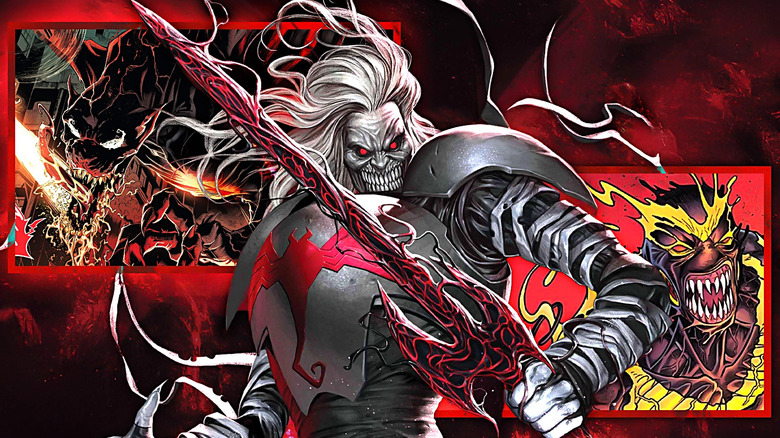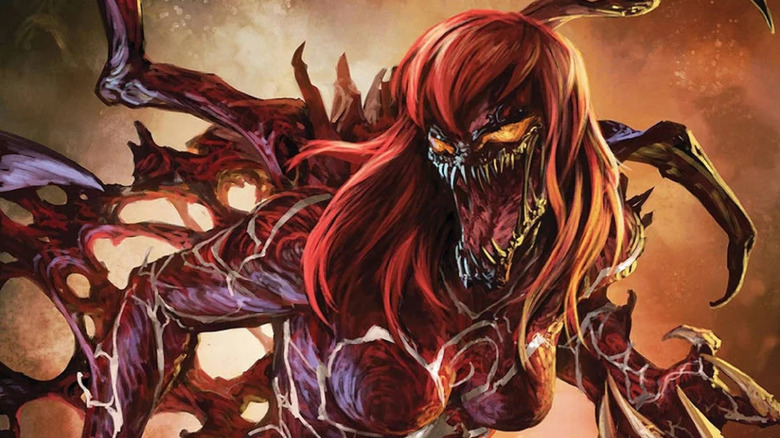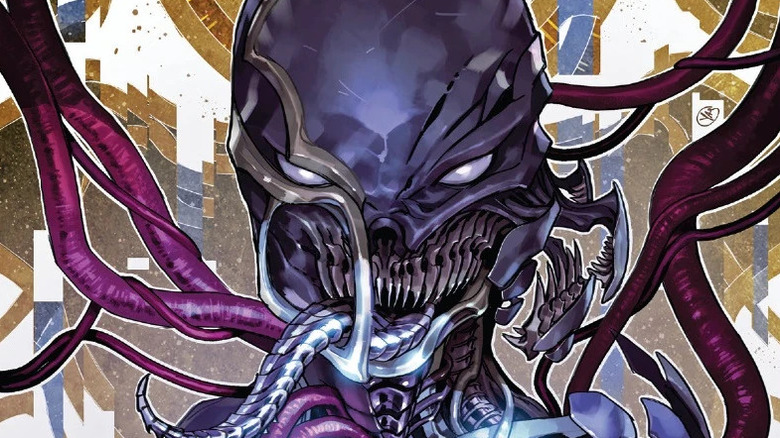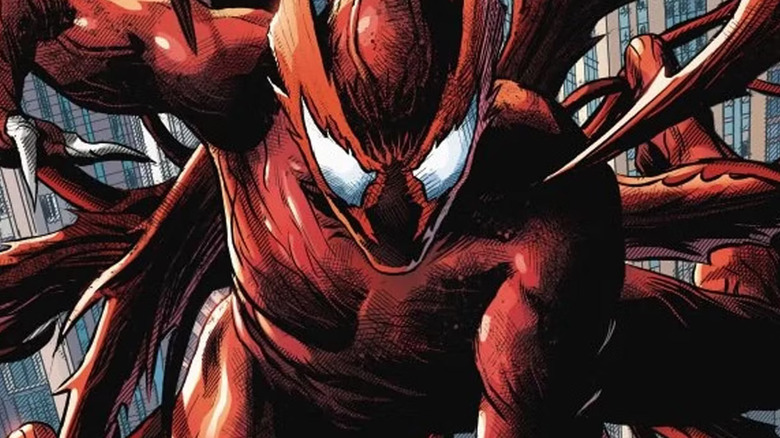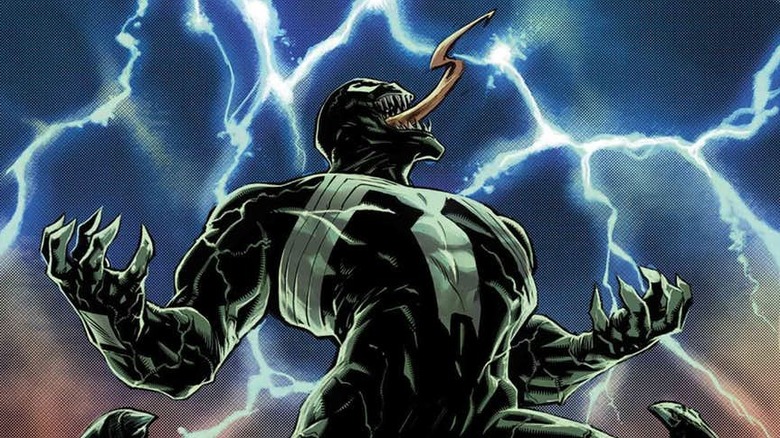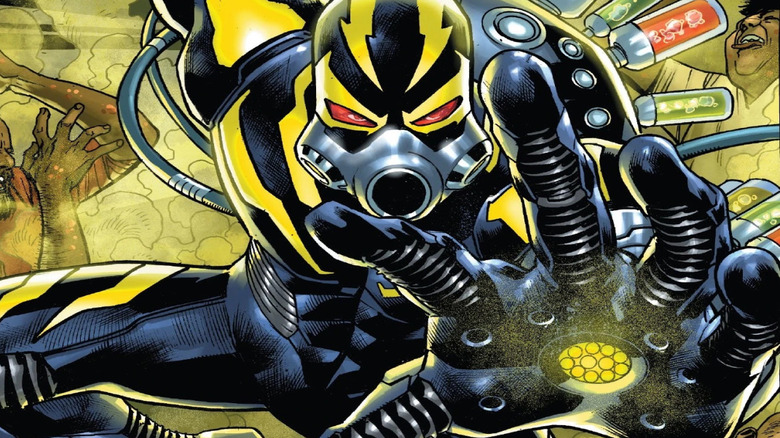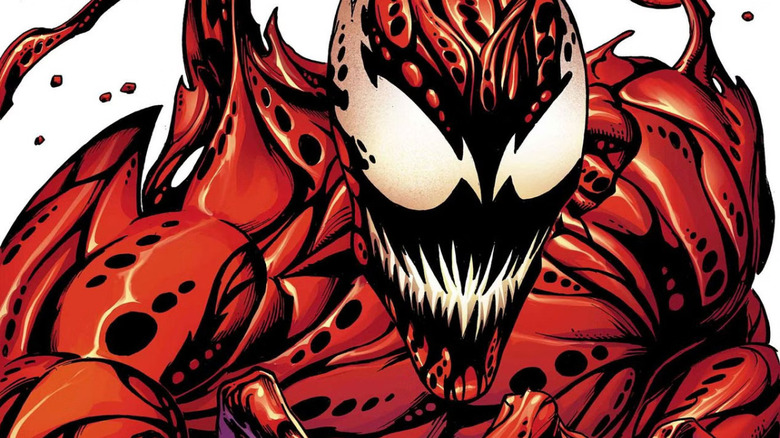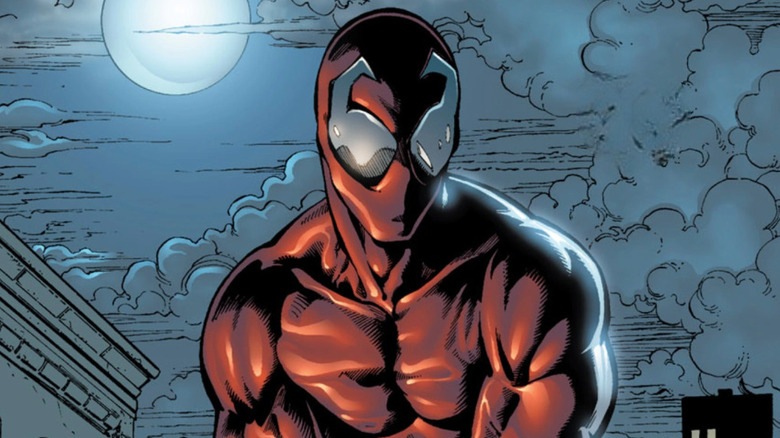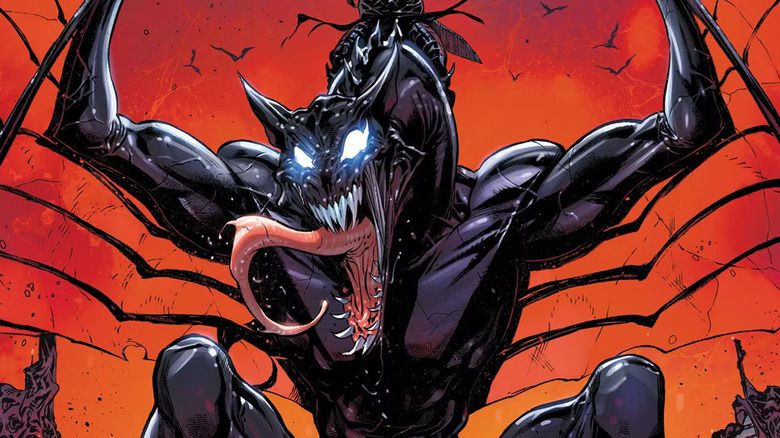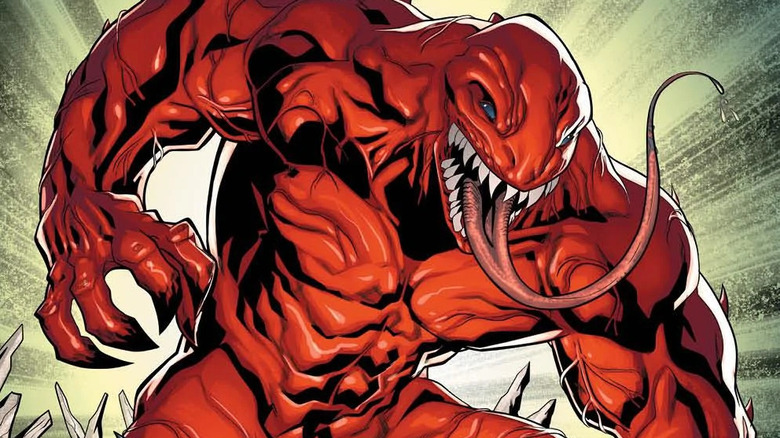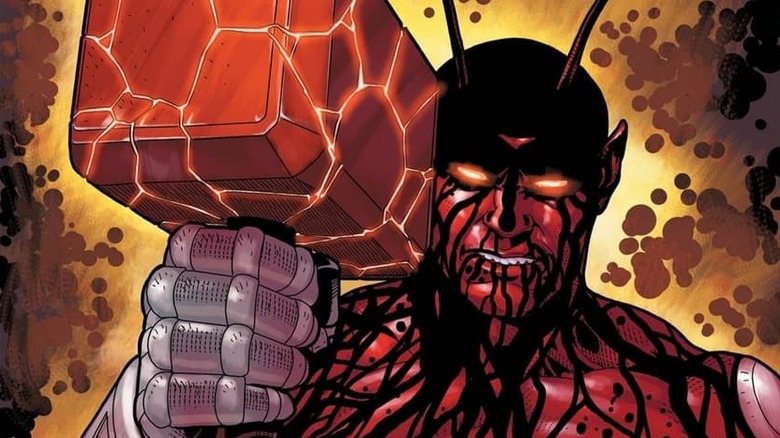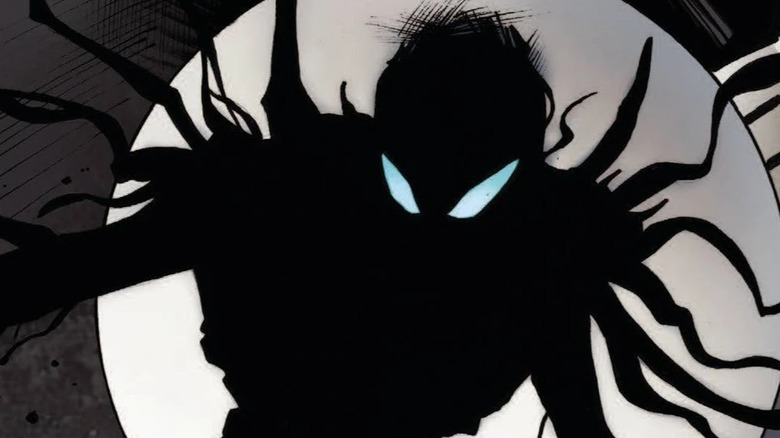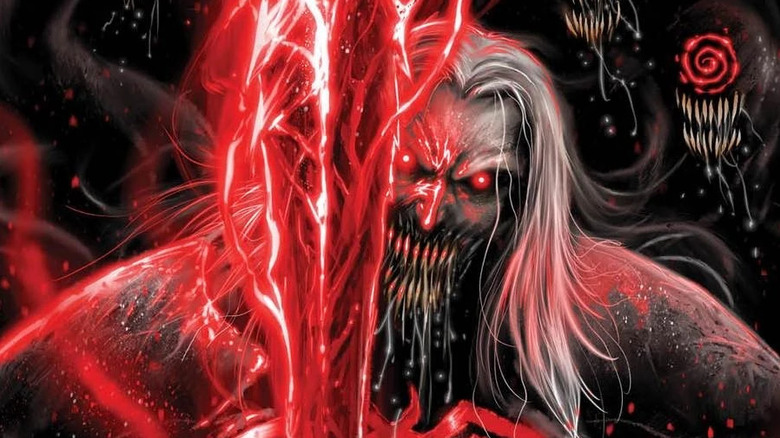Venom: Marvel's 12 Strongest Symbiotes, Ranked
We may receive a commission on purchases made from links.
Spider-Man has one of the most iconic rogues galleries in comics. From the Green Goblin to Doctor Octopus, his enemies are almost as famous and recognizable as he is — but none compare to Venom.
An alien symbiote that grants its host a rad costume and some seriously dangerous powers, it has become one of the most popular recurring enemies in the entire Marvel Comics Universe. Countless writers since the character's debut in the '80s have explored the ever-evolving history of the symbiotes as a race, tracking their origins all the way back to the dawn of the universe and expanding their ranks to include cosmic entities, mythical creatures, and even lower-case-g gods.
Especially after seeing so many of these symbiotes (albeit in a mostly disappointing way) in "Venom: The Last Dance," we were curious which symbiote reigns supreme. Ignoring versions of the symbiotes seen in films and focusing mostly on the powers of the creatures themselves rather than the superbeings they might bond with, we've determined the 12 strongest symbiotes in Marvel Comics.
12. Misery
Liz Allan has had one of the roughest lives of any "Spider-Man" supporting player, which is really saying something. Recent comic book storylines have tried to rework characters in small ways, like focusing on her work as the CEO of Alchemax. Part of her work has been studying the symbiotes that have invaded Earth in an attempt to better understand how they could help humanity — a goal that has basically blown up in the face of every scientist before her.
While studying strains of both the Carnage symbiote and the abnormal Anti-Venom symbiote, the two substances combine to form a hybrid symbiote that calls itself Misery and bonds with Allan. She gains the powers of two of Marvel's strongest symbiotes as a result, and she could arguably be placed a little higher on this list depending on how you interpret the implications of such a combination. However, we feel the bottom of the top 12 is a fair spot for Misery, given that it comes with the massive drawback of the two symbiotes being biologically incompatible with one another, due to Anti-Venom's anti-symbiote abilities.
11. Scorn
In the 2011 "Carnage: Family Feud" miniseries, readers were introduced to the title symbiote's second offspring: Scorn. Having been literally ripped to pieces by The Sentry after attempting to escape the ultra-maximum security supervillain prison known as The Raft, the Carnage symbiote was trapped in a weakened state by an ambitious tech entrepreneur hoping to use samples of the alien biological substance to enhance prosthetic limbs... because comics.
During the course of their study, Cletus Kasady was kept locked up nearby, while his longtime girlfriend Shriek was psychologically coerced by psychiatrist Tanis Nieves into using her powers to further subdue the symbiote. When Shriek and Carnage's old "Maximum Carnage" pet Doppelganger tries to break them out, Nieves loses an arm and accepts one of the experimental symbiote prosthetics. As a result, she is eventually forced into bonding with the Carnage symbiote temporarily. This led to the production of the Scorn symbiote, which somehow manifested technopathic powers and an immunity to harmful frequencies as a result of its unique birth.
Unlike Carnage's first-born, Scorn does not seem to possess the same exponential strength relative to its progenitor, at least not when bonded to Nieves. That said, it's certainly more deadly than your garden variety symbiote, even before factoring in its technological capabilities.
10. Hybrid
Readers who remember 2018's "Venom" may remember that Riz Ahmed's evil tech billionaire Carlton Drake played the CEO of the Life Foundation, a corporation that secretly studied symbiotes for their potential benefit to mankind. In the comics, the Life Foundation was a cult-like business organization that prepared for potential nuclear doomsday by forcing the captive Venom symbiote to produce offspring that would serve the Foundation and its surviving members long after the bombs had dropped. Among the five spawn produced were Agony (capable of spitting acid from its mouth), Phage (superior senses to its siblings), Lasher (superior tendrils), and Riot, the strongest of them all.
These individual powers combined with the normal gifts and physical augmentations provided by the symbiotes would be dangerous enough, but when these four were combined into one super-symbiote (leaving behind their fifth sibling, Scream), they became even more powerful. Interestingly enough, however, they didn't become deadlier, as the frightened aliens developed a no-kill rule in reaction to the brutal behavior of their sibling Venom and their harsh treatment by the Life Foundation. They enforced this rule on their most prominent host, Scott Walker. The Hybrid symbiote is currently without a host in the comics, having been missing and presumed in-hiding after a failed attempt to absorb Scream during the "King in Black" event.
9. Venom
Finally, we arrive at the most famous symbiote of them all: Venom. This is also where our attempts to rank these creatures become fairly difficult, as the various different versions of Venom range from street-level lethal protector to cosmic-level destroyer of gods. In determining this ranking, we went with the most normal, commonly seen version of the character in the comics — the alien "suit" that came to Earth, bonded with Peter Parker/Spider-Man, then joined forces with his professional nemesis Eddie Brock.
Venom is, for the most part, the peak of the average symbiote. He's held his own against numerous powerful enemies over the years since his debut in 1988's "Amazing Spider-Man" Issue #300, including Ghost Rider, the unstoppable Juggernaut, the cosmic guardian Nova, and of course, Spider-Man himself. The symbiote has also bonded to an abnormally large number of hosts: In addition to Parker and Brock, the goo has been hosted by Mysterio, Otto Octavius (during his run as the "Superior" Spider-Man), the Scorpion (who served as a member of Norman Osborn's Dark Avengers during this time), Flash Thompson (who exercised unparalleled control over the costume under the alias Agent Venom), Captain Marvel, the entire Guardians of the Galaxy, Brock's wife, Anne, and son, Dylan, and, most recently, Mary Jane Watson.
After being touched by "Mister Negative" Martin Li's Lightforce, Brock's body and the Venom symbiote create an artificial symbiote referred to as Anti-Venom, which was later destroyed in the comics. It's also worth mentioning that, at the climax of the "King in Black" event which saw Knull, the Symbiote God descend on Earth, a dying Eddie Brock was granted the powers of Captain Universe (an ultra-powerful cosmic superhero) and re-bonded with Venom to create a god-like version of the character more powerful than any seen previously.
8. Sleeper
During a time when Eddie Brock was working with biotech company Alchemax (and their CEO Liz Allan), Venom gave birth to a symbiote that would eventually be called Sleeper. Because Brock had experienced through Carnage just how psychologically malleable the symbiotes were as newborns, he insisted that the offspring not be immediately bonded to a host (certainly not Alchemax's choice, the Scorpion), so it would have the chance to grow into a normal living being. These wishes were honored until an invading Kree (Venom's first host before Peter Parker) released it prematurely.
Sleeper is still a more compassionate symbiote as a result of being cared for during its early days, during which it evolved to have the ability to produce and manipulate chemicals at will, as well as uniquely strong stealth capabilities. The full version of Sleeper is seemingly stronger than Venom (as is expected of symbiote offspring), though it is currently being held captive for forced expulsion from Earth in the Marvel Comics Universe. It was able to leave a piece of itself free, which transforms its host into the "Sleeper Agent." Sleeper exerts more control over its hosts than other symbiotes, once even able to survive piloting a lobotomized corpse.
7. Carnage
The second most famous symbiote next to Venom (thanks in part to his headlining appearance in the 2021 "Venom" sequel "Let There Be Carnage"), Carnage was the first symbiote spawn in the comics. Because Eddie Brock had been in prison when Venom happened to give birth (for lack of a better phrase), Carnage immediately bonded itself to one of his fellow inmates, the deranged serial killer Cletus Kasady.
There is some debate among comic book fans and the comics themselves about how this choice of a host affected the symbiote itself. Back before Venom had been rehabilitated into an anti-hero, both symbiotes were written as amplifying primal feelings within the host, such as anger and bloodlust. As such, a psychopath like Kasady was considered a perfect match for a symbiote, resulting in a unity so strong that Carnage was one being.
However, subsequent comics have implied that the Carnage symbiote was potentially not inherently violent or evil but was instead overwhelmed by Kasady's mind upon bonding, and it took on Kasady's personality and, potentially, even his consciousness. When Norman Osborn wore the Carnage symbiote as the "Red Goblin," he briefly believed he had become Kasady.
Following (and establishing) the conventional symbiote offspring logic, Carnage is exponentially stronger than Venom, and not even the combined strength of Brock and Spider-Man can take him down. He's brushed off missiles, thrashed a Nova, defeated Luke Cage, chewed through Wolverine's adamantium claws, and even gave Magneto some trouble. In the comics, Carnage's current host is actually Eddie Brock, who is attempting to use the symbiote for good — so far, it's going about as well as you'd expect.
6. Toxin
Of all the traditional Marvel symbiotes, Toxin is by far the strongest. Toxin is the offspring of Carnage, making it the grandchild of Venom, as well as the 1,000th spawn in their shared family tree. Because Toxin is initially bonded to a relatively upstanding New York police officer named Patrick Mulligan, the symbiote develops more balanced morality starting out. Mulligan even tries to live a "normal" life as a vigilante for a time, before the writers decided to move on from Mulligan as a host entirely.
Narratively, Toxin has been kept as a supporting player in "Spider-Man" and more recent "Venom" storylines, so we don't necessarily have many examples of it going up against threats in the wider Marvel Universe. However, it is said to be much stronger than both Carnage and Venom — perhaps even combined — and is significantly less predictable due to its abnormal psychology. Since leaving Mulligan, Toxin has bonded with (surprise, surprise) one Eddie Brock, who used it both as a traditional Venom-type, monstrous symbiote suit and a more controlled "Agent" suit while Venom itself was bonded to Flash Thompson.
As of writing, Toxin has been un-bonded with its teen host Bren Waters, who used it for (mostly) heroic acts. Its future is unclear, though it is planned to be jettisoned off-planet as soon as possible.
5. Grendel
Chances are, if you've been casually paying attention to "Venom" and "Spider-Man" comics over the past couple years, you've seen a picture of symbiote dragon Grendel online. While you could reasonably assume that this is simply a dragon or similar mythical creature being used as a host by an ambitious symbiote, it's actually a living symbiote in and of itself that is so powerful it needs no host to survive — though that doesn't mean it can't take one if it chooses.
Grendel was one of the first symbiotes created by Knull during his initial quest for universal dominance, having been deployed against Thor during ancient times (in the history of the Marvel Universe, this incident inspired the "Beowulf" legend). After Thor managed to defeat it, Grendel was trapped for thousands of years in a block of ice, which eventually found its way to SHIELD's Weapon Plus program (the same program that gave us Captain America and Wolverine). Under the project codenamed "Weapon V," Grendel's symbiotic biomatter was used to enhance American soldiers during the Vietnam War. Timelines are tricky in comics, but unless the current iteration of Eddie Brock and Spider-Man are pushing 100, this would mean Grendel was the first symbiote to infect a host on Earth. It is capable of infecting multiple hosts at once, and it can control them as a hive mind.
4. Bedlam
Unfortunately for us, not as much is known about Bedlam as other symbiotes on this list, and what we do know about it is pretty confusing. In the aftermath of the "King in Black" storyline, Eddie Brock effectively ascended to cosmic, symbiote godhood and was driven mad in the process, resulting in a version of him (called Meridius) creating a time loop that spawned further variants based on diverging choices made by Brock. During this story arc, Brock comes face-to-face with one of the variants who — in addition to possessing the cosmic powers of a King in Black like Brock at that point — has become so lost in his symbiote that they have become a perverse, unified being that has totally consumed anything humanly resembling Eddie Brock.
This symbiote, calling itself Bedlam, has the ability to take over the consciousness of any symbiote it desires, and it has physical characteristics greater than other symbiotes on this list. After Brock uses his own god-like symbiote powers to take Bedlam down in a one-on-one grudge match, he reduces the being to a proper symbiote in search of a host. He takes its power for himself and uses it to stop Meridius once and for all.
3. Serpent
Another very new symbiote that was born in the aftermath of "King in Black," Serpent's history is even more convoluted. It was born when Bedlam fought against Darkoth, an old "Fantastic Four" villain who transformed from a normal man into a demonic, Latverian legend by Doctor Doom. In a timeline where Darkoth was able to defeat Bedlam and separate the remnants of Eddie Brock from the symbiote, it gave birth to an offspring that would come to be known as Serpent.
Serpent bonded to Darkoth, using the unique gifts of its first host to craft a dark version of Thor's hammer Mjolnir dubbed Hellnir. Because Serpent was able to draw strength from its superpowered host and its birthright as a spawn of a King in Black, it was an unusually powerful newborn symbiote that would have been able to kill Thor himself if Eddie Brock hadn't intervened to give the Asgardian a power boost. They were able to separate Serpent from Darkoth, though (thanks again to its King in Black gifts) the symbiote was able to escape — eventually finding a new host for itself in Thor's former Midgardian host, Donald Blake.
2. Mister E
For nearly four decades, comic fans could be in agreement that the first appearance of a symbiote being was in 1984 during the original "Secret Wars" event, which saw Peter Parker don the black Spider-Man suit for the first time. Things have gotten a little more complicated since then, thanks to the retroactive history of the powerful symbiote Mister E.
Mister E is a living symbiote entity who first appeared in a 1980 issue of "Marvel Spotlight," in which he came to Earth with dreams of destroying the sun by turning it into a black star. During this attack, he exhibited his ability to infect hosts and turn them into symbiote servants. At the time of the comic's release, this was explained vaguely as Mister E having a connection to some kind of shadow universe. During the "King in Black" event, however, it was revealed that he actually had a connection to the Living Abyss, the substance he and every other early symbiote was created from by Knull.
It took the might of Captain Universe to take down Mister E originally, though he eventually returned during the period in which Spider-Man was host to the symbiote. He once again boasts incredible, near-unstoppable powers, but he was ultimately slayed for good by the Ebony Blade of the Black Knight.
1. All-Black the Necrosword
Strangely enough, the most powerful symbiote of them all is not a "suit" but a "sword" — All-Black the Necrosword, wielded primarily by the god of symbiotes himself, Knull. Readers may remember the character from his brief appearance in "Venom: The Last Dance," in which he was portrayed by "Let There Be Carnage" director Andy Serkis. His comic book lore has made him a villain so terrifying that even the mere hint of his presence within the Marvel Cinematic Universe in "Thor: Love and Thunder" has us hoping for more down the road.
All-Black is the very first symbiote ever created in the Marvel Universe, molded from Knull's own shadow billions upon billions of years in the past. When Knull used this blade to cut off the head of a Celestial — the same head that has since been hollowed out and turned into a hub of intergalactic activity, now known as Knowhere — All-Black was bonded in part to the cosmic entity's essence, granting it the unique ability to send its victims to an afterlife outside of those otherwise known by the deities of the Marvel Universe.
Speaking of these deities, All-Black is such a powerful symbiote that it grants whoever bonds with it the ability to slay gods. This was a power Knull took somewhat for granted, but was deeply relished by the vengeful Gorr (Christian Bale's character from "Love and Thunder"), who came into possession of the blade and anointed himself the "God Butcher." It is a planet-killing weapon in the right (or wrong) hands, and seemingly possesses a degree of its own will which it can project onto its hosts (including Loki, Galactus, and Ego the Living Planet). In the hands of Knull, it became one of the most iconic weapons in contemporary comics — otherwise, it's easily the strongest symbiote of them all.
